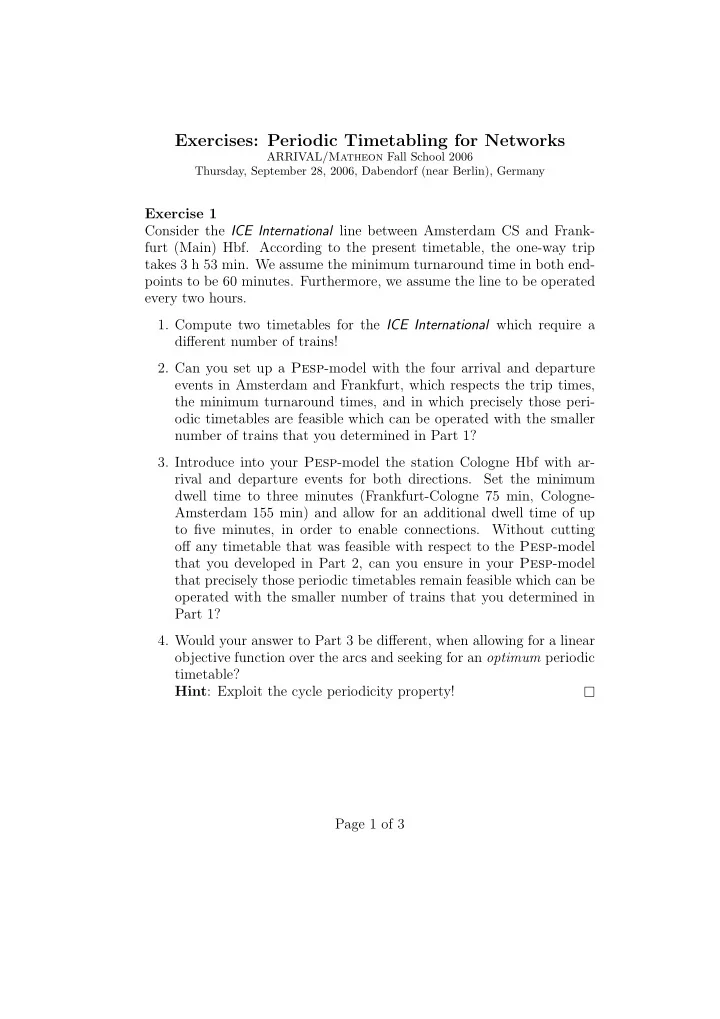

Exercises: Periodic Timetabling for Networks ARRIVAL/ Matheon Fall School 2006 Thursday, September 28, 2006, Dabendorf (near Berlin), Germany Exercise 1 Consider the ICE International line between Amsterdam CS and Frank- furt (Main) Hbf. According to the present timetable, the one-way trip takes 3 h 53 min. We assume the minimum turnaround time in both end- points to be 60 minutes. Furthermore, we assume the line to be operated every two hours. 1. Compute two timetables for the ICE International which require a different number of trains! 2. Can you set up a Pesp -model with the four arrival and departure events in Amsterdam and Frankfurt, which respects the trip times, the minimum turnaround times, and in which precisely those peri- odic timetables are feasible which can be operated with the smaller number of trains that you determined in Part 1? 3. Introduce into your Pesp -model the station Cologne Hbf with ar- rival and departure events for both directions. Set the minimum dwell time to three minutes (Frankfurt-Cologne 75 min, Cologne- Amsterdam 155 min) and allow for an additional dwell time of up to five minutes, in order to enable connections. Without cutting off any timetable that was feasible with respect to the Pesp -model that you developed in Part 2, can you ensure in your Pesp -model that precisely those periodic timetables remain feasible which can be operated with the smaller number of trains that you determined in Part 1? 4. Would your answer to Part 3 be different, when allowing for a linear objective function over the arcs and seeking for an optimum periodic timetable? Hint : Exploit the cycle periodicity property! � Page 1 of 3
Exercise 2 Consider the hourly Brandenburg RegionalExpress lines RE3 and RE5: • Elsterwerda/Senftenberg – Dabendorf – Berlin Lichterfelde Ost – Berlin Gesundbrunnen – Stralsund/Schwedt • Lutherstadt Wittenberg/Falkenberg – Berlin Lichterfelde Ost – Berlin Gesundbrunnen – Rostock/Stralsund. In principle, the northern branches of these two lines could be inter- changed without having too severe impacts with respect to direct trav- ellers. Provide an excerpt of the PESP model for Brandenburg northbound regional traffic in the station Berlin Lichterfelde Ost in which the assign- ment of southern branches to northern branches is not fixed a priori. 1. What are the four relevant events at Berlin Lichterfelde Ost and which lines/branches are associated with them? 2. Introduce arcs which ensure that the two lines are more or less equally spaced over time, i.e. that a cyclic distance of 25 minutes is accepted, but 24 minutes are not! 3. Introduce line assignment arcs between the four vertices that ensure that a node potential vectors π satisfies all your constraints, if and only if for every arrival event there exists exactly one departure event that occurrs between one and three minutes after the arrival event! Hint : Make use of disjunctive constraints , which involve parallel arcs, and profit from the “more or less equally spacing” that you � ensure by having solved Part 2. Exercise 3 You are given an instance ( D, ℓ, u ) of the Periodic Event Scheduling Problem . Moreover, you are given a vector x that is defined on the arcs of D such that x a ∈ [ ℓ a , u a ] , ∀ a ∈ A, and which satisfies the cycle periodicity property for every oriented circuit of D . 1. Can you derive from x a node potential vector π such that ( π j − π i − ℓ a ) mod T ≤ u a − ℓ a , ∀ a = ( i, j ) ∈ A ? � 2. If so, how? Page 2 of 3
Exercise 4 Consider the following directed graph D . 1 7 6 2 4 8 5 3 1. Find a non-integral cycle basis B of D . 2. Which oriented circuits of D are an integer linear combinations of the circuits of B ? Consider the following vector x that is defined on the arcs of A : x T := (20 , 20 , 20 , 20 , 15 , 15 , 15 , 15) . 3. For which oriented circuits of D does the vector x satisfy the cycle periodicity property? � Exercise 5 ∗ Consider any orientation of the generalized Petersen-graph P 11 , 4 . Determine a weight function w on the edges of P 11 , 4 such that the unique minimum cycle basis of your weighted version of P 11 , 4 is not integral. Hint : You may argue easily over all the circuits of P 11 , 4 by observing that the bold edges of P 11 , 4 form a cut. Moreover, there exists a weight function with weights in { 4 , 5 , 12 } . � Page 3 of 3
Recommend
More recommend